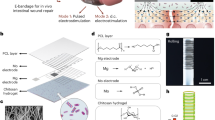This device spares the need for surgical intervention by simulating natural limb growth.
Abstract
Biological regeneration of the extremities can occur in some organisms (starfish, for example), but humans need recourse to a mechanical solution. Growing children present a particular challenge, and those who lose bone tissue from the knee after removal of a tumour need an implant that can not only provide stability for the femur and allow motion of the knee joint, but which also accommodates rapid growth. Here we describe a self-extending leg implant (endoprosthesis) that can closely simulate natural growth and which has worked successfully in paediatric patients. The energy needed for elongation of this device is provided by the patients themselves as a result of flexure of the knee joint, thereby reducing the number of operations and the risk of infection associated with manually extended implants.
This is a preview of subscription content, access via your institution
Access options
Subscribe to this journal
Receive 51 print issues and online access
$199.00 per year
only $3.90 per issue
Buy this article
- Purchase on Springer Link
- Instant access to full article PDF
Prices may be subject to local taxes which are calculated during checkout

Similar content being viewed by others
References
Chao, E. Y. S. & Sim, F. H. in Tumor Prostheses for Bone and Joint Reconstruction: Design and Application (eds Chao, E. Y. S. & Ivins, J. C.). 335–359 (Thieme, New York, 1983).
Kotz, R., Ritschl, P. & Trachtenbrodt, J. Orthopedics 9, 1639– 1652 (1986).
Scales, J. T., Sneath, R. S. & Wright, K. W. J. in Limb Salvage in Musculoskeletal Oncology (ed. Enneking, W. F.) 52–60 (Churchill Livingstone, New York, 1987).
Lewis, M. M., Spires, W. P. Jr & Bloom, N. in Limb Salvage in Musculoskeletal Oncology (ed. Enneking, W. F.) 606–610 (Churchill Livingstone, New York, 1987).
Kotz, R., Schiller, C., Windhager, R. & Ritschl, P. in Limb Salvage: Major Reconstructions in Oncologic and Nontumoral Conditions (eds Langlais, F. & Tomeno, B.) 591–599 (Springer, Berlin, 1991).
Eckardt, J. J. et al. in Limb Salvage: Major Reconstructions in Oncologic and Nontumoral Conditions (eds Langlais, F. & Tomeno, B.) 585– 590 (Springer, Berlin, 1991).
Schiller, C. et al. J. Bone Jt Surg. 77B, 608– 614 (1995).
Mittermeyer, F. et al. Clin. Orthoped. (submitted).
Windhager, R., Robioneck, B., Bien, M., Müller, H. & Kotz, R. Medizinisch Orthopadische Technik 115, 152–154 (1995).
Author information
Authors and Affiliations
Corresponding author
Rights and permissions
About this article
Cite this article
Kotz, R., Windhager, R., Dominkus, M. et al. A self-extending paediatric leg implant. Nature 406, 143–144 (2000). https://doi.org/10.1038/35018155
Issue Date:
DOI: https://doi.org/10.1038/35018155
This article is cited by
-
Tumorendoprothetik
Der Orthopäde (2021)
-
Wachstumsprothesen nach Sarkomresektionen im Kindes- und Jugendalter
Der Orthopäde (2019)
-
Progress in musculoskeletal oncology from 1922 – 2012
International Orthopaedics (2014)
-
Wachstumsprothesen zur Rekonstruktion von Defekten der unteren Extremitäten beim Kind
Operative Orthopädie und Traumatologie (2012)
-
Megaprothesen: KMFTR® bis GMRS®
Der Orthopäde (2010)
Comments
By submitting a comment you agree to abide by our Terms and Community Guidelines. If you find something abusive or that does not comply with our terms or guidelines please flag it as inappropriate.



